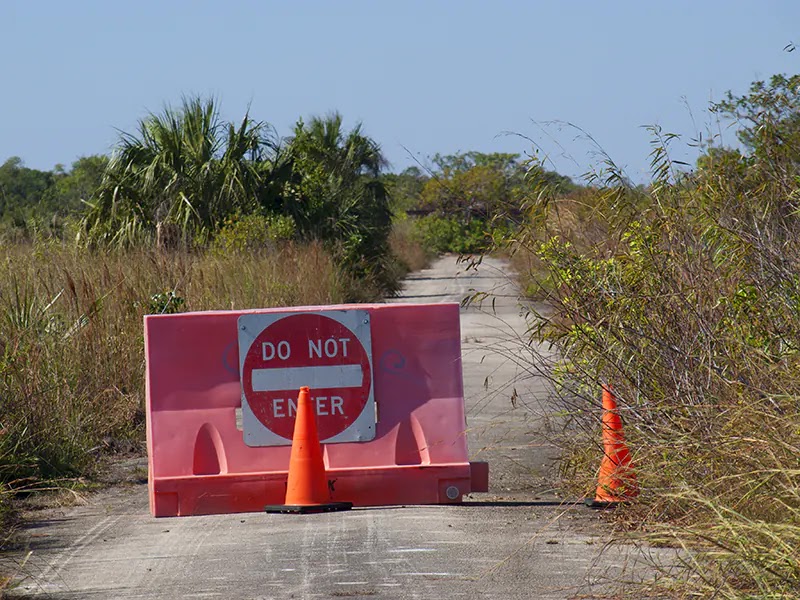Paynes Prairie
A sea of wildflowers in the spring. Birds, wild horses, bison,
deer, and alligators are at home in the old Alachua Savanna explored
by
William Bartram in 1774. This is also the first preserve created in Florida.
The campground is in a humid forest. Walking on the prairie always felt
better. By the entrance there is a visitor center and the Wacahoota
Trail - means "cow barn". It's a short trail. We climbed the fifty-foot
tower for wide views of the savanna. Flocks of birds and wild horses grazing
faraway. The horses came from the Spanish ranches of colonial times. The bison
returned in 1975. They came from the
Wichita Mountains Wildlife Refuge. In Bartram's times, there were also wolves in Paynes Prairie.
Hernando De Soto came to this place in 1539 and met the
Potano Indians. Later, the Alachua Band of the
Seminole occupied these lands.
Micanopy
The city of Micanopy is close to the entrance of Paynes Prairie State Park. The oldest
inland town of Florida is often called "the town that time forgot". Yep, it's old. Main
street with its big oaks runs on an old Indian trading route. Most of the old buildings are cafes and antique shops. There is also
the Herlong Mansion, a majestic home from 1915 near a warehouse from 1890s that serves as the historical museum of the town.
Micanopy means "high Chief" or "head Chief", said to be in reference to
Hulbutta Hajo - "Crazy Alligator". When Bartram came there
was a Seminole village here named Cuscowilla. With the
Second Seminole War, Micanopy became Fort Defiance and was the place of two battles in 1836:
the Battle of Micanopy and the Battle of Welika Pond. The
first fight involved 75 American soldiers against 200 Seminole led
by
Osceola. The second one was an Indian ambush a mile from the fort. Eleven soldiers
were wounded - some died later. The American troops abandoned and burnt Fort Defiance
and the town but came back in 1837 and build Fort Micanopy. Wild
stories from the old frontier.
Gainesville
This is the closest big city to Paynes Prairie. We stopped by the Florida Museum of Natural History to meet the
biggest T-Rex of the world. Sue was a sizable "girl" 42 feet
long and 13 tall. The truth is that nobody knows the sex. "Sue" is
for the lady that found the remains. This giant roamed America 67
million years ago - once, we saw
their footprints in the "wild". Usually, "she" lives in a museum of Chicago, but sometimes travels on loan. Lucky us that was here. The Butterfly Rainforest was
also a cool exhibit.
We also went to the art museum and the sunset got us waiting for the bats at
the University of Florida bat houses. Half a million of three bat species live
in the two shelters. They are
Brazilian free-tailed bats,
southeastern bats, and
evening bats. When the sun was gone, the bats emerged in a dense cloud. A hawk attacked
and got one. They clapped their wings over our heads flying away. Two minutes and they were gone.
Devil's Millhopper in northern Gainesville was another place we visited. This
is a small geological park at a sinkhole 120 feet deep that attracts tourists since the 19th century. Down there is humid and plenty of vegetation. Water
slides on the rocks forming many mini waterfalls. There is a pond at the
bottom of the sinkhole. Many fossils
have been found here, including shark teeth that talk of an underwater Florida. Why the name Devil's Millhopper? Just old tales about this sinkhole as the tool to feed dead bodies to the
devil.
Kanapaha Botanical Garden is west of Gainesville on the shores of Lake
Kanapaha. This is the biggest herbs garden in the southeast of the US and
the largest display of bamboos in Florida. "Kanapaha" is a Timucuan word
that may mean "thatched house". Native American artifacts were found at the
lake shores. William Bartram camped here in 1774.
There we walked among flowers, bromeliads, bamboos, herbs, and conifers. There
are two sinkholes in the property. I stood close to a rattlesnake hidden
under some plants, but she decided not to bite. Rattle noise and a fast crawling into the forest. What a scare. We saw postings warning of a water moccasin
nest by the creek.
We drove west of Kanapaha to visit the Historic Haile Homestead but was
closed. This was the slave plantation of a family from South Carolina that
moved here in the 1850s. The interesting thing is that the Hailes used to
write notes on the walls of the house. They scratched 12,500 words. The
plantation was called Kanapaha and produced cotton. This area was
known as Arredondo after a Spanish landowner. The property of
this man was so big that included the whole Paynes Prairie -
check an old map from 1876 where you can also see the town of Micanopy.
Now the graphic part of the post, time for some images.

|
| High humidity is a thing in the campground area of the state park. The campsites are surrounded by a forest of oaks
covered by Spanish moss. Lake Wauburg is nearby. The wind always blows better
in the prairie.
|

|
|
The observation tower at the border of Paynes Prairie. The photo is taken from the prairie. Looks like a good set for a movie of King Kong. |

|
| Here we see the short Wacahoota Trail and the Cone's Dike Trail. On the bottom, a few wild horses grazing faraway in the
prairie. Bison we didn't see - only found their poop in Cone's Dike Trail. |

|
| There is plenty of wildlife in this state park. We got many pictures. |

|
|
The center of the historical Micanopy. All nice and quiet in this rural setting. The population of this town is a little over 600. |

|
| The Old Florida Cafe and antique stores in the historic district of Micanopy.
|

|
The Herlong Mansion built in 1915 is the jewel of Micanopy. And you can sleep here because it's a bed and breakfast - check the Herlong Mansion website for photos and more details. |

|
| This is the historical museum of Micanopy and some of the exhibits. At the bottom: old drawing of Fort Micanopy, archaeological findings of the area,
and Confederate money. The building of the museum is a warehouse from 1890s - learn about the Thrasher Warehouse. |
 |
| The T-Rex "Sue" in the Florida Museum of Natural History in Gainesville. This fella is pretty big. |

|
| Close-up of this amicable "lady". She needs to visit a dentist. |

|
| Yes, we found more old stuff from land, air, and water in the Florida Museum of Natural History. |

|
|
The bat houses of the University of Gainesville, Florida. Note the hawk waiting for its daily meal on the
fence.
|

|
|
The bats flying over our heads.
|

|
|
The cloud of bats going away for a feeding frenzy. They will be out for the night. |

|
|
The stairs of the Devil's sinkhole in Gainesville, Florida. Some locals come to exercise here. |

|
|
Plants and wildlife in the Devil's sinkhole. A lot of green down here. |

|
|
The amazing Kanapaha Botanical Garden in Gainesville, Florida.
|

|
| We found a collection of crazy colors in the flowers of Kanapaha Botanical Gardens. |

|
| But, of course, there is also a green side in the Kanapaha gardens - check the bamboos. |























Comments
Post a Comment